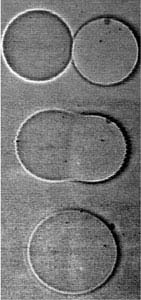Tiny ’test tubes’ may aid pharmaceutical R&D

A series of three photos show two lipsomes fusing into one. <br>
Using laser light as tweezers and a scalpel, scientists from the National Institute of Standards and Technology (NIST) have demonstrated the use of artificial cells as nanovials for ultrasmall volume chemistry. The approach may be useful for faster, cheaper identification of new pharmaceuticals and for studying cellular-level processes. The researchers will report their results in the Sept. 30 edition of Langmuir.
The artificial cells, called liposomes, are tiny spherical containers that self-assemble from natural fats (phospholipids and cholesterol). Measuring micrometers in diameter, the fluid-filled membranes are currently used in cosmetics and for drug delivery.
The NIST team developed an improved method for using liposomes as tiny test tubes for mixing chemicals with volumes measured in trillionths of liters. Their experimental setup allows simultaneous trapping of two liposomes without deforming or stressing their membranes, a problem with some other techniques. They used pairs of infrared lasers (“optical tweezers”) to bring two liposomes into contact and a single ultra-violet laser pulse (the “optical scalpel”) to fuse the two cells together. Once fused, the contents of the two cells mix and react. One liposome in each pair contained fluorescent dye, and the other contained calcium ions. After the cells merged, fluorescence increased as a result of the reaction between the dye and the ions.
The optical scalpel achieves cleaner fusion and less leakage of contents than the typical technique using pulsed electric fields. The liposomes fully enclose their reactant chemicals, minimizing evaporation. Consequently, the technique also may be useful for quantitative studies of chemical reactions involving samples in the quadrillionths of liters.
Media Contact
All latest news from the category: Process Engineering
This special field revolves around processes for modifying material properties (milling, cooling), composition (filtration, distillation) and type (oxidation, hydration).
Valuable information is available on a broad range of technologies including material separation, laser processes, measuring techniques and robot engineering in addition to testing methods and coating and materials analysis processes.
Newest articles

A universal framework for spatial biology
SpatialData is a freely accessible tool to unify and integrate data from different omics technologies accounting for spatial information, which can provide holistic insights into health and disease. Biological processes…

How complex biological processes arise
A $20 million grant from the U.S. National Science Foundation (NSF) will support the establishment and operation of the National Synthesis Center for Emergence in the Molecular and Cellular Sciences (NCEMS) at…

Airborne single-photon lidar system achieves high-resolution 3D imaging
Compact, low-power system opens doors for photon-efficient drone and satellite-based environmental monitoring and mapping. Researchers have developed a compact and lightweight single-photon airborne lidar system that can acquire high-resolution 3D…





















